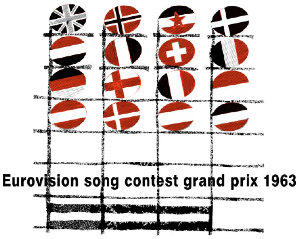Eurovision Song Contest 1963
| Eurovision Song Contest 1963 | |
|---|---|
 |
|
| Dates | |
| Final | 23 March 1963 |
| Host | |
| Venue |
BBC Television Centre London, United Kingdom |
| Presenter(s) | Katie Boyle |
| Conductor | Eric Robinson |
| Director | Yvonne Littlewood |
| Host broadcaster | British Broadcasting Corporation (BBC) |
| Interval act | Ola & Barbro |
| Participants | |
| Number of entries | 16 |
| Debuting countries | None |
| Returning countries | None |
| Withdrawing countries | None |
| Vote | |
| Voting system | Each country had 20 jury members who awarded their five favourite songs 5, 4, 3, 2, and 1 points in order. All those points would then be added up and the five song with the most points got 5, 4, 3, 2, and 1 votes in order. |
| Nul points | |
| Winning song |
"Dansevise" |
The Eurovision Song Contest 1963 was the eighth annual Eurovision Song Contest. The contest was held in London, United Kingdom, after the British broadcaster BBC stepped in to organise the event. France had won the 1962 edition with the right to host this following one but were unable to, due to financial shortcomings.
The contest was won by Denmark with the song "Dansevise", performed by Grethe & Jørgen Ingmann. Denmark's win was their first. Four countries got nil points, with Finland, Norway and Sweden failing to score any points for the first time and The Netherlands for the second time, becoming the first country to go two years in a row without scoring a single point.
The BBC was willing to host the contest instead of the previous year's winner France, as was the case in 1960, 1972 and 1974 with previous winning broadcasters that could not afford to organise a contest.
The host venue was the BBC Television Centre, White City, London, which opened in 1960. It is one of the most readily recognisable facilities of its type having appeared as the backdrop for many BBC programmes. It remained to be one of the largest such facilities in the world until it closed in March 2013.
Two studios (TC3 and TC4) were used: one for the mistress of ceremonies Katie Boyle, the audience, and the scoreboard; the other for the performers and the orchestra accompanying them. Unusually, a boom microphone (normally used for drama and comedy shows) was employed - the viewer doesn't see this, so it appears as if the artists were miming to their vocals. This was not the case, but this innovation was to create a new look for the contest.
...
Wikipedia


